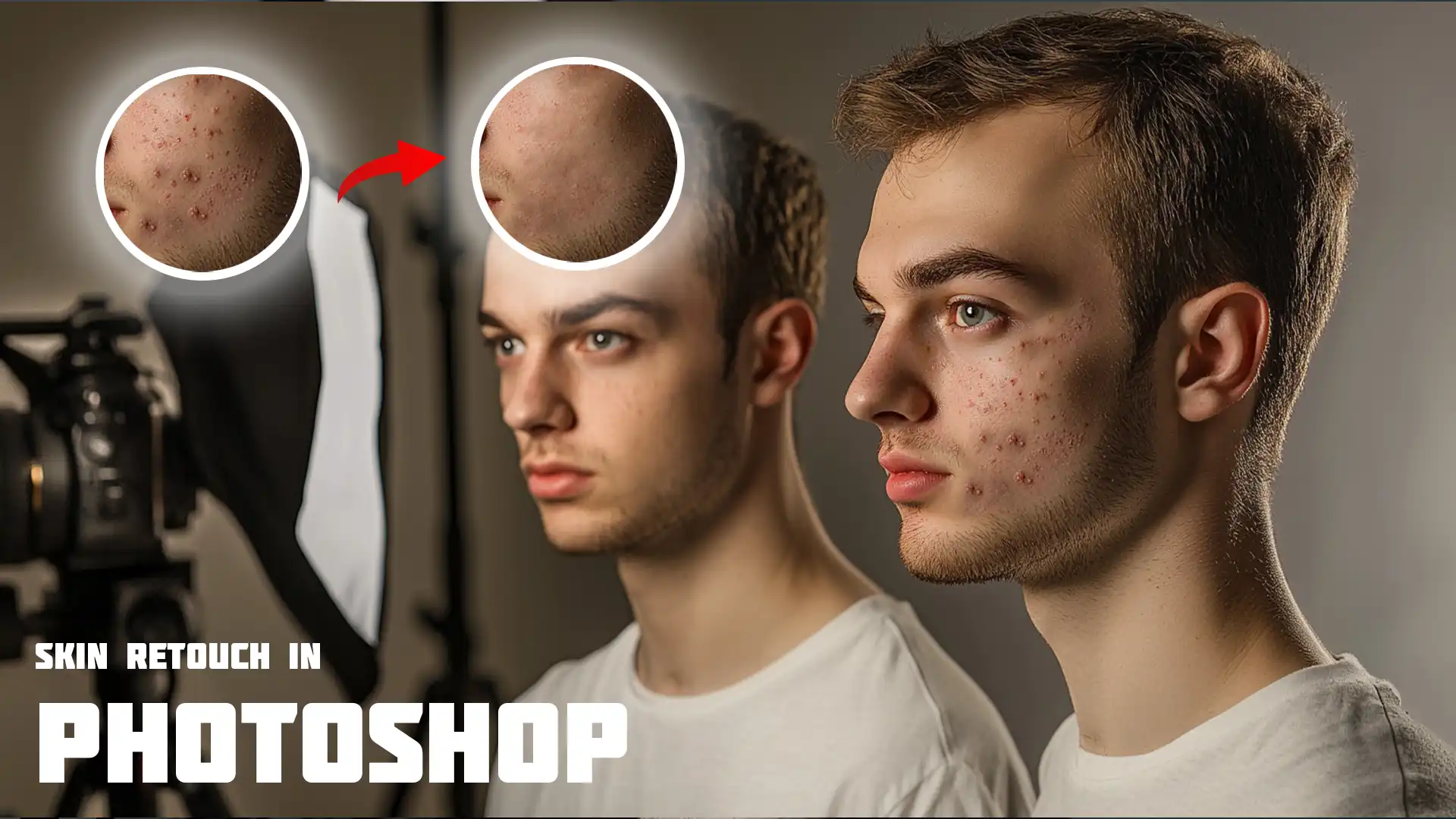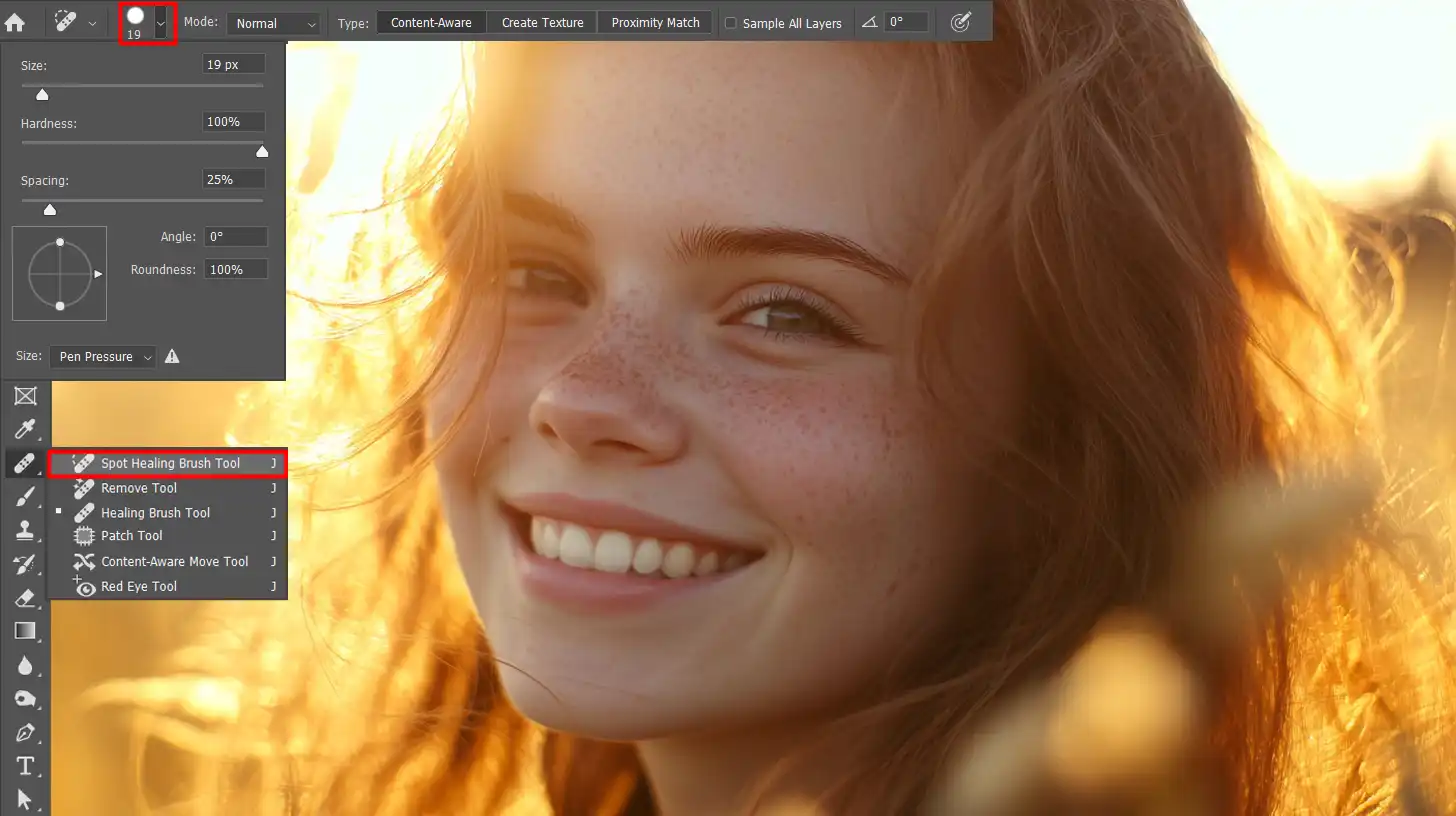
Mastering Photoshop retouch skills is significant when we talk about refining our photos.
Imagine transforming your not-so-perfect shots into magazine cover masterpieces!
That’s what effective retouching can do.
Whether it’s smoothing out skin, adjusting lighting, or correcting colors, the power to enhance photographs lies at your fingertips.
Learning important Photoshop techniques ensures that every picture you take tells a story more beautifully and vividly.
Let’s dive into how these skills can elevate your photography game and capture the true beauty of your moments.
Table of Contents
Professional Skin Retouching
Are you ready to improve your photo editing skills?
In this guide, I’ll show you how to achieve smooth skin and enhance skin texture using Adobe Photoshop.
Achieve flawless portraits by learning how to clear away blemishes in Lightroom, complementing professional skin retouching in Photoshop.
Combine both tools for impeccable skin perfection.
Essential Tools for Skin Retouching
To get started, you must familiarize yourself with the necessary tools for skin retouching.
These essential tools in Photoshop include the spot healing brush, clone stamp tool, and healing brush tools.
Each tool serves a unique purpose in creating flawless images.
Tool Purpose:
The Spot Healing Brush tools quickly removes blemishes and minor imperfections.
The clone stamp tool replicates pixels to cover larger areas.
The Healing Brush Tools Blends the repaired area with the surrounding skin texture.
Clone Stamp Tool in Photoshop
The clone stamp tool in Photoshop is a powerful feature for duplicating image parts.
This tool allows you to copy pixels from one part of an image to another, making it ideal for retouching and removing imperfections.
Here’s how to use it:
Select the Clone Stamp Tool
- Open Photoshop and load your image.
- Select the Clone Stamp Tool from the toolbar on the left or press the shortcut key S.

Choose a Source Area:
- Hold down the Alt key (Option on Mac) and click on the area of the image you want to copy. This sets the source point.
Start Cloning:
- Release the Alt key and move to the area where you want to apply the clone.
- Click and drag to paint the cloned pixels onto the new area.
Adjust Settings:
- You can use the options bar at the top to adjust brush size, hardness, and opacity for more precise cloning.
Blend Seamlessly:
- For a natural look, frequently reset the source point.
- Adjust the flow and opacity settings to blend the cloned area seamlessly with the surrounding pixels.
Step-by-Step Skin Retouching Process
Follow these steps to achieve a natural look in your portraits:
- Open your image in Photoshop.
- Duplicate the background layer to preserve the original image.
- Select the spot healing brush and adjust the brush size to match the blemishes.
- Use the healing brush tools to blend the repaired areas.
- Apply adjustment layers to fine-tune skin tones and shadows.
Using Adjustment Layers for Final Touches
Adjustment layers are important for achieving the perfect skin tones.
They allow you to adjust the color and brightness without altering the original image.
Here’s how:
- Create a new adjustment layer for color balance.
- Fine-tune the skin tone to match the desired look.
- Use a layer mask to apply adjustments selectively.
Maintaining Natural Beauty
While photo retouching is significant, it’s important to maintain the subject’s natural beauty.
Avoid over-editing and focus on enhancing the natural look of the skin.
Pro Tip: Mastering professional skin retouching requires practice and patience.
Using the right tools and techniques, you can automate creating stunning portraits with Photoshop action for portraits highlighting the subject’s natural beauty.
Step-by-Step Skin Retouching Process
To achieve professional-looking skin retouching, follow these simple steps to enhance your images while preserving natural beauty.
Starting with the basics, you’ll learn how to open your photo and create a duplicate layer for non-destructive editing.
Step 1: Open and Duplicate Image
Start by opening your image in Photoshop.
Always duplicate the image layer to preserve the original before retouching.
This step is important for nondestructive editing.
Step 2: Select Spot Healing Brush Tool for Minor Retouching
Choose the Spot Healing Brush from the toolbar.
This tool is excellent for removing minor blemishes quickly.
Adjust the brush size to match the blemish size.

Step 3: Remove Blemishes
With the spot healing brush in Photoshop, click on the blemishes to remove them.
This tool blends the surrounding texture seamlessly, giving a natural look.
Step 4: Copy Layer
Duplicate the layer again.
This new layer will be used for further retouching.
It’s important to keep your edits organized.
Step 5: Apply High Pass Filter
Go to Filter > Other > High Pass. Set the radius to around 2-3 pixels.
This step enhances the retouching details in the skin texture.
Step 6: Apply Gaussian Blur
Next, apply a gaussian blur to the same layer.
This helps smooth out the skin while retaining significant details. Set the radius to 1-2 pixels.
Step 7: Change Mode to Vivid Light
Change the blend mode of the layer to Vivid Light.
This mode helps in enhancing the contrast and details of the skin.
Step 8: Add Layer Mask
Add a layer mask to the current layer.
This mask will allow you to control where the effect is applied, ensuring precision in your edits.

Step 9: Use the Brush Tool to Reveal the Effect
Select the Brush Tools and paint over the areas where you want the retouch effect to be visible.
Use a soft brush for smooth transitions.
Step 10: Check and Adjust the Smoothing Effect
Finally, review your retouch work. Adjust the opacity of the layer if needed to achieve a natural look.
Ensure the skin looks smooth but not overly edited.
| Action | Tool |
|---|---|
| Open and Duplicate Image | Photoshop |
| Select Spot Healing Brush | Spot Healing Brush |
| Remove Blemishes | Spot Healing Brush |
| Copy Layer | Photoshop |
| Apply High Pass Filter | High Pass Filter |
| Apply Gaussian Blur | Gaussian Blur |
| Change Mode to Vivid Light | Blend Mode |
| Add Layer Mask | Layer Mask |
| Use Brush Tool to Reveal Effect | Brush Tool |
| Check and Adjust Smoothing Effect | Photoshop |
This table outlines the steps and tools used in the Photoshop workflow.
Importance of Skin Retouching
Smooth skin retouching is important for creating polished and professional photos.
It enhances the subject’s natural attractiveness while removing imperfections.
Let’s explore why it’s so important.
Enhancing Natural Beauty
Retouching is a piece of basic knowledge and can bring out the best in your subjects.
It highlights their permanent features and ensures they look their best.
Removing Imperfections
Using tools like the patch and clone stamp tools, you can easily remove skin blemishes and other imperfections, making the skin look flawless.
Creating a Professional Look
Professional photographers use skin retouching to give their photos a polished look.
This can make a massive difference in the final image.
Improving Client Satisfaction
Clients are often more satisfied with retouched photos.
They appreciate the extra effort to make them look their best.
Tools for Skin Retouching
There are many tools available in Photoshop for skin retouching.
Some of the most popular include:
- Patch Tool
- Clone Stamp Tool
- Adjustment Layers
Additionally, you can explore Adobe Photoshop and enhance your projects with Adobe Lightroom.
For flawless results, skin smoothing in Photoshop is important. Utilizing effective tools for skin retouching, such as the Spot Healing Brush and high pass filter in Photoshop, ensures a polished finish.
Advanced Retouching
Ready to elevate your Photoshop retouch skills?
These bonus tips will help you achieve professional results.
Whether you’re working on portraits or landscapes, these techniques will make your images stand out.
Use the Patch Tool for Blemishes
The patch tool is perfect for removing blemishes and minor imperfections.
Select the area you want to fix, then drag it to a clean area.
This tool blends the selected area seamlessly.

Adjust Skin Tones with Adobe Camera Raw
For natural-looking skin tones, use Adobe camera raw.
Open your image in camera raw, and adjust the temperature and tint sliders.
This method works well for different skin types.
Enhance Eyes and Teeth
Create a new layer, and use the brush tool to paint over the eyes and teeth.
Adjust the opacity for a natural look.
Use Multiple Images for Composites
Creating composites with multiple images can add depth to your work.
Use layers to blend the images seamlessly. This technique is great for creative projects.
Refine Hair with Masking
Masking is significant for refining hair in portraits.
Use the quick selection tool to select the hair, then refine the edges using the refine edge brush.
This method keeps the hair looking natural.
Control Shadows and Highlights
Adjusting shadows and highlights can add depth to your images.
Use the adjustment layer to fine-tune these elements. This technique enhances the overall look of your photos.
Enhance your skills by learning to master Photoshop shadows, which is indispensable for controlling shadows and highlights. Discover techniques to balance lighting and elevate your image editing.
Save Your Work in Different Formats
Save your work in various formats, such as JPEG files and PSDs.
This ensures you have a high-quality version for printing and a web-friendly version for online sharing.
Use Adjustment Layers for Non-Destructive Photo Editing
Always use adjustment layers for non-destructive photo editing.
This allows you to make changes without altering the original image.
It’s a great way to experiment with different looks.
Unlock powerful editing by using adjustment layers in Photoshop, which is important for non-destructive photo editing. Master these layers to enhance images seamlessly without altering the original.
Frequently Asked Questions (FAQs)

How to retouch in Photoshop?
To Photoshop retouch , first open the image.
Use the spot healing tool for minor blemishes.
Utilize adjustment layers to perfect skin tones. Add new layers to ensure non destructive edits.
The clone stamp tool and other retouch tools can achieve smooth skin.
How do you retouch a product in Photoshop?
Start by opening the product image in Photoshop.
Use the healing brush tool or clone stamp tool to remove imperfections. Adjust color and tone with an adjustment layer.
Enhance details using sharpening tools to create a polished, professional look.
What are the retouching tools in Photoshop?
Photoshop offers numerous retouching tools, including the spot healing tool brush, cloning stamp tool, and patch tool.
The brush tool also aids in retouching.
Each helps fine-tune images, remove blemishes, and enhance skin texture and details.
How to use Retouch
Retouching in Photoshop involves a few importnant steps to enhance and perfect your images:
- First, open Your Image
- Second, duplicate the Layer
- Then, use the Spot Healing Brush Tool
- Utilize Adjustment Layers
- Clone Stamp Tool for Detailed Retouching
- Smooth Skin and Enhance Texture
- Use the Brush Tool with a Layer Mask
- Check and Adjust the Smoothing Effect
Conclusion
Mastering the art of Photoshop retouch opens up endless possibilities for enhancing your images.
Whether you aim to achieve smooth skin, remove unwanted objects, or adjust background elements, understanding the basics of tools like Photoshop is important.
The tutorial shows how to effectively use adjustment layers to make nondestructive edits that preserve the original image’s features.
To apply the right techniques, it’s important to consider the skin type and specific requirements of each portrait.
For instance, using the clone stamp for imperfections or adjustment layers for color correction can significantly improve the final output.
Retouching is not just about making faces look flawless but also about enhancing the overall image while maintaining natural textures and details.
For more in-depth tutorials and tips, check out our Photoshop Course and Lightroom Course.
These courses are designed to elevate your photo editing skills further.
Mastering these techniques will ensure that each retouched creation looks beautifully detailed, even without the richness of RGB color.
Explore the possibilities and refine your skills to make your images stand out.
Read more about Photoshop:














